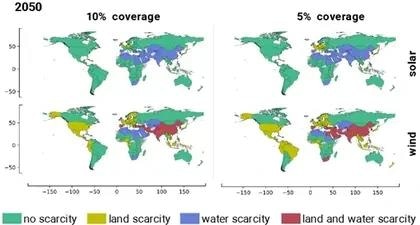As renewable energy sources such as wind and solar expand, they could be used to manufacture hydrogen fuel in a sustainable manner. However, adopting such a system on a big scale necessitates the dedication of land and water to this purpose.
 An illustration showing land and water scarcity induced by meeting 2050 hydrogen production demands using wind and solar power under two different land coverage scenarios. This image is courtesy of the authors and was created using Matplotlib and Geopandas packages for Python. Image Credit: Carnegie Science
An illustration showing land and water scarcity induced by meeting 2050 hydrogen production demands using wind and solar power under two different land coverage scenarios. This image is courtesy of the authors and was created using Matplotlib and Geopandas packages for Python. Image Credit: Carnegie Science
A recent study published in Nature Communications by Carnegie’s Lorenzo Rosa and visiting scholar Davide Tonelli from ULB and UCLouvain examines the problems of addressing various hydrogen demand projections on a country-by-country basis.
Electrolysis is a process of creating hydrogen in which water is divided into oxygen gas and hydrogen gas, which could then be stored and utilized as fuel or feedstock to generate valuable chemicals. This process can be fueled by fossil fuels such as coal or natural gas, or by renewable energy sources like wind and solar, both of which require space to be installed.
Today, hydrogen is mostly used in refineries and the production of chemicals. But in the future, demand for hydrogen could increase more than fivefold, due to adoption of hydrogen or hydrogen-derived products in transportation, industrial heating methods, and steel manufacturing techniques. There is an opportunity to meet this increased demand with sustainably produced hydrogen.
Lorenzo Rosa, Principal Investigator, Department of Global Ecology, Carnegie Institute for Science
He and Tonelli discovered that less than half of the anticipated 2050 demand for hydrogen fuel could be produced and consumed locally using wind or solar power due to a lack of land or water. They conducted this research in collaboration with Carnegie visiting scholar Paolo Gabrielli of ETH Zurich, Ken Calderia of Carnegie, Alessandro Parente of ULB, and Francesco Contino of UCLouvain.
If you look at how much water would be needed globally to produce enough hydrogen to meet humanity’s needs in 2050, it’s only 0.6 percent of the world’s available water. But when you look at local production for local use, the picture can be different.
Davide Tonelli, Visiting Student, Carnegie Institute for Science
It turns out that in a world without carbon emissions, some countries would have to rely on importing hydrogen, either in pure form or in the form of products derived from hydrogen, from other nations that have greater land abundances and more advantageous solar and wind resources that could be used to sustainably produce it in large quantities.
Rosa and Tonelli discovered that the abundance of land and water in Southern Africa, Central-East Africa, West Africa, South America, Canada, and Australia might make them prospective leaders in the export of hydrogen. On the other hand, Western Europe, Trinidad & Tobago, South Korea, and Japan would probably have to reduce current industrial production or import hydrogen fuel.
The researchers stress the value of conducting national assessments of the resources that various countries are prepared to commit to hydrogen generation.
Tonelli added, “Our work indicates countries that have the resources to ramp up sustainable hydrogen production for export. But, of course, social, political, and economic factors will determine the extent of installation of renewable technologies and hydrogen production from each nation, which may differ from what would be feasible on paper.”
This study is a part of Rosa’s larger initiative to examine the potential and difficulties associated with the intersection of the production of food, water, and energy, all of which are impacted by climate change and population expansion.
Rosa concluded, “As we strive to mitigate greenhouse gas pollution and prepare for the ways that climate change will affect where we live, how we build and sustain communities, and how we feed ourselves, it is crucial that we robustly examine various climate solutions to understand the possibilities that they present, as well as any unintended consequences.”
Journal Reference:
Tonelli, D., et al. (2023) Global land and water limits to electrolytic hydrogen production using wind and solar resources. Nature Communications. doi:10.1038/s41467-023-41107-x